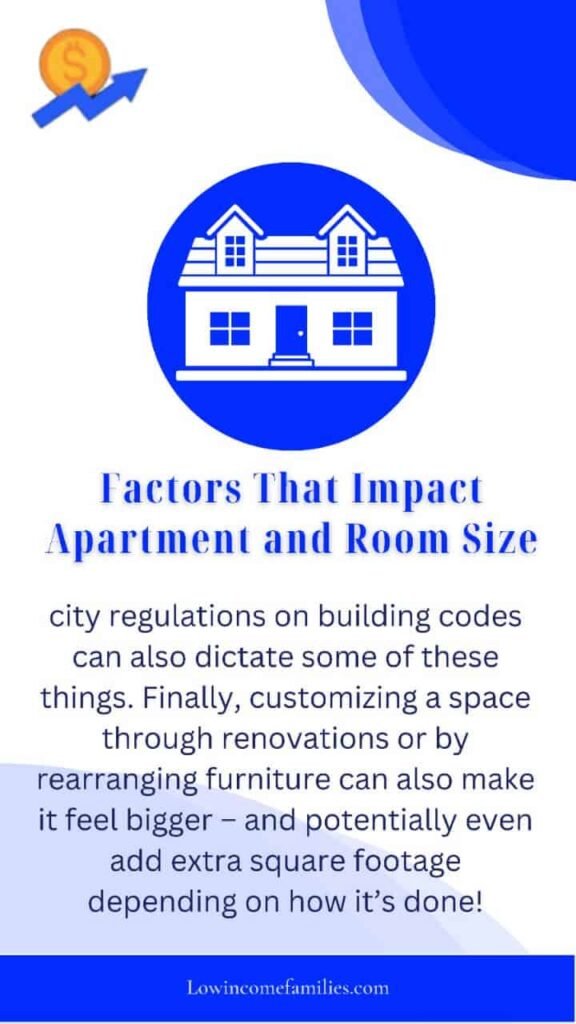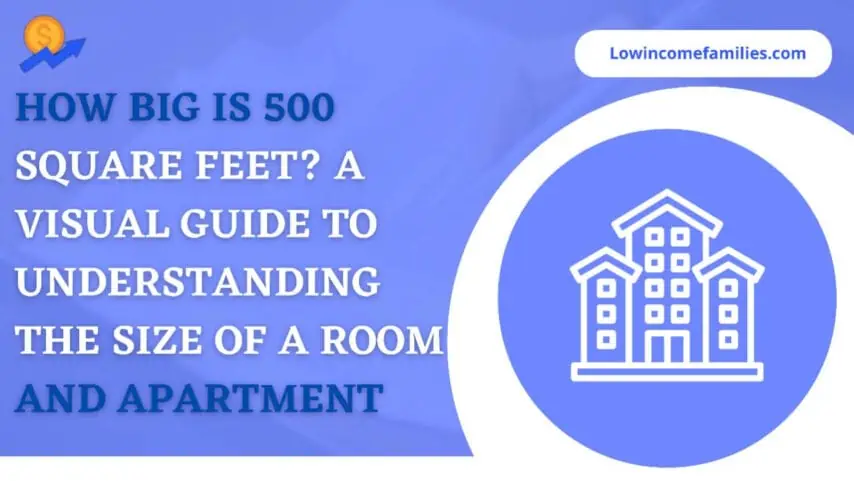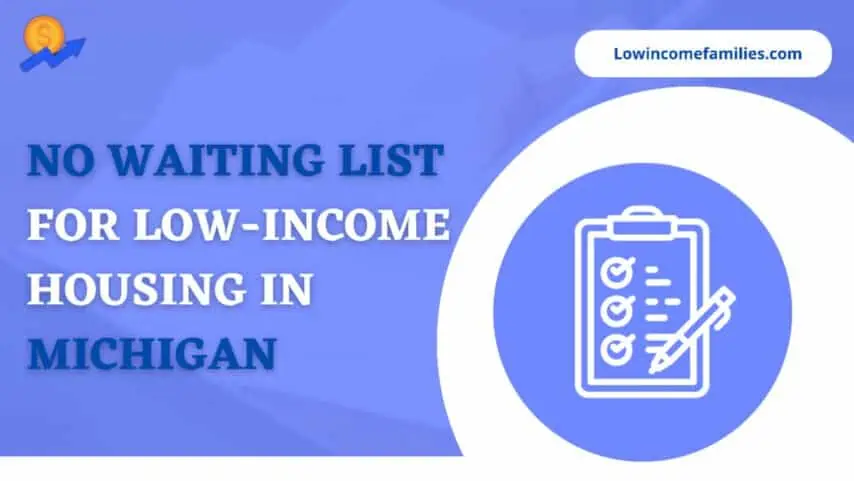Have you ever wondered how big 500 square feet is? Not everyone is instinctively familiar with the measurements of a room or apartment and it might be hard to visualize the size just by looking at the number.
In this blog post, we’ll break it down by using visuals and real-life examples so that you can know exactly how much space you are looking at when considering 500 square feet.
How Big Is 500 Square Feet?
Welcome to our visual guide on how big are square feet. In this guide, we’ll provide you with an overview of the size of a room and an apartment, as well as some helpful tips on understanding square footage.
As you probably know, square footage is a measure of area, and it’s commonly used to determine the size of a room or an apartment. But what does that mean in terms of length and width?
A good way to think about it is by imagining a square. One square foot is equal to the area of a square that measures one foot on each side. So, if you drew a square on the floor that was one foot long and one foot wide, that would be one square foot.
Now let’s say you have a room that’s 10 feet long and 10 feet wide. That means the room has 100 square feet of area because 10 squares are each one foot long and one foot wide.
The same principle applies to apartments. If an apartment is 500 square feet, that means it has 25 squares that are each 20 feet long and 20 feet wide.
Now that you know how to visualize square footage, let’s talk about some tips for understanding it better.
Check Also: Best Luxury Apartments That Accept Section 8 Vouchers
What Do 500 Square Feet Represent?
One of the most common questions we get here at Apartment Therapy is “How big are 500 square feet?” Our answer is always the same: it depends.
500 square feet can represent a studio apartment, a one-bedroom apartment, or even a large two-bedroom apartment. It all depends on the layout of the space and how you plan to use it.
For example, a studio apartment with a single room and a kitchenette would be considered small, while a studio with an open floor plan and a separate bedroom would be considered large.
The same goes for one-bedroom apartments – 500 square feet can feel like a palace or a closet, depending on the layout.
Two-bedroom apartments also come in all shapes and sizes, but 500 square feet is generally on the smaller side. This is because most two-bedroom apartments have at least one living room and one bedroom, which can take up a lot of space.
However, if you’re looking for a more spacious two-bedroom apartment, you may be able to find something around 700 or 800 square feet.
In short, the size of a room or an apartment doesn’t necessarily have anything to do with its square footage. It’s all about how you use the space and what kind of layout you’re working with.
Check Also: Renting with bad credit but high income 2023, Read More Here
Factors That Impact Apartment And Room Size
The size of a room or apartment is determined by several factors, including the type of dwelling (e.g., single-family home, townhouse, condominium, etc.), the number of rooms, the floor plan, and the dimensions of the unit.
In addition, the size of furniture and appliances can also impact the overall square footage of space. For example, a one-bedroom apartment typically has about 600 square feet of living space, whereas a two-bedroom apartment may have closer to 900 square feet.

Similarly, a small studio apartment might only be 400 square feet, while a larger loft-style unit could be upwards of 1,200 square feet. Ultimately, it’s important to consider all of these factors when determining how big or small a particular space might be.
In addition, the age of the dwelling can have an impact on room and apartment size as well. Older buildings may have smaller rooms due to different architectural styles over time, while newer units may offer updated amenities like larger kitchens or bathrooms.
And, of course, city regulations on building codes can also dictate some of these things. Finally, customizing a space through renovations or by rearranging furniture can also make it feel bigger – and potentially even add extra square footage depending on how it’s done!
If don’t know Check Also: How big is 300 square feet?
Visual Aids To Understand 500 Square Feet
When it comes to square footage, one size doesn’t fit all. Just how big are square feet? It can be hard to wrap your head around, so we’ve put together some visual aids to help you understand.
First, let’s start with the standard room size. A bedroom in a typical house is about 12 feet by 12 feet or 144 square feet. That’s not very big! But if you think about it, it’s just enough room for a bed, a dresser, and maybe a small desk or table.
Next, let’s compare that to a larger space like a living room. A typical living room is about 16 feet by 20 feet or 320 square feet. That extra space can make all the difference when you’re trying to relax or entertain guests.
Now let’s talk about apartment sizes. A studio apartment is usually around 400 square feet, which is just enough room for a small kitchenette and living area in addition to the bathroom and bedroom area.
One-bedroom apartments start at around 600 square feet, while two-bedroom apartments are typically 900 square feet or more. As you can see, the size of a room or an apartment can vary greatly.
But with these visual aids, you should have no trouble understanding what 500 square feet look like about other spaces.
Calculating The Size Of A Room Using Square Footage
Many people don’t know how to calculate the size of a room using square footage. This can be especially confusing when trying to figure out the size of an apartment.
Here is a simple guide to help you understand how big square feet are and how to calculate the size of a room using this measurement. Square footage is simply the measurement of a room or space in terms of its length and width.
To calculate the square footage of a room, you would simply multiply the length by the width. For example, if a room was 10 feet long and 10 feet wide, it would have 100 square feet of floor space.
Keep in mind that not all rooms are rectangular. Some may have alcoves or other spaces that need to be accounted for when calculating square footage. The best way to get an accurate measurement is to use a tape measure and measure each wall individually.
Once you have these measurements, you can add them all up to get the total square footage for the room. Now that you know how to calculate square footage, you can use this information to figure out just how big (or small) your room or apartment is!
Have any confusion in 1000 sqft, Check Also: How big is 1000 square feet?
Types Of Rooms That May Fit In 500 Square Feet
Several different types of rooms may fit in 500 square feet. For example, a one-bedroom apartment typically has a living room, kitchen, and bathroom that combine to take up about this amount of space.
Additionally, many hotel rooms are designed to be around 500 square feet. In terms of specific dimensions, 500 square feet is equivalent to 25×20 feet or 50×10 feet.
Assuming an average ceiling height of eight feet, this means that a room measuring 500 square feet would have the following dimensions: 25 ft x 20 ft x 8 ft (length x width x height).
However, keep in mind that actual ceiling heights can vary quite a bit depending on the type of building you’re in. So, for example, if you’re considering a lofted space, the ceiling height could be much greater than 8 feet.
Examples Of Furniture Layouts In A 500 Square Foot Apartment
When it comes to furnishing a small room or apartment, every square foot counts. That’s why it’s important to carefully consider the layout of your furniture to make the most of the space you have.
Here are some examples of how you can effectively furnish a 500-square-foot room or apartment:-
Option 1 :- Use multifunctional furniture pieces to save space. For example, opt for a coffee table that doubles as a storage ottoman and invest in a sofa bed for guests.
Option 2 :- Create distinct areas within the same space. For example, use an area rug to define the living room from the dining area.
Option 3 :- Get creative with your storage solutions. Utilize wall space with shelving units and hanging baskets. Keep items off the floor with floating shelves and Stackable storage bins.
Option 4 :- Use mirrors and reflective surfaces to create the illusion of more space.
Option 5 :- Keep furniture close to the walls to free up floor space in the center of the room. Strategically position furniture so that it creates conversation areas while still leaving plenty of room to walk around.
Alternatives To Consider For Small Spaces
-
Look For Multifunctional Furniture
When you’re working with a small space, it’s important to be mindful of how you can make the most of what you have. One way to do this is by investing in multifunctional furniture pieces that can serve multiple purposes.
For example, a coffee table that doubles as a storage ottoman or a daybed can be used as both a sofa and a guest bed.
-
Get Creative With Your Layout
Just because your space is small doesn’t mean you have to stick to one particular layout. Be creative with your furniture arrangement and think outside the box when it comes to how you use your space.
For example, if you have a narrow hallway, consider using it as a makeshift home office or reading nook.
-
Utilize Vertical Space
When you’re dealing with limited square footage, it’s important to make use of all the space you have—including Vertical space. This means things like hanging shelves on walls, installing floating cabinets in kitchens and bathrooms, and utilizing over-the-door storage solutions.
-
Bring In Mirrors
Mirrors are not only functional but they can also help make a small space feel larger and brighter. Place mirrors opposite windows or near light sources to reflect light and create the illusion of more space.
Conclusion :-
Understanding the size of a room or apartment is essential when planning to make changes. Knowing how big 500 square feet is gives us a better idea of what can and cannot fit in it.
Changing our expectations and allowing us to create smart plans for living comfortably within this space. Hopefully, this article has provided you with an insight as to what 500 square feet might look like.
Visualizing it more clearly so that you have a good reference point when making decisions regarding purchasing or renting any kind of dwelling. With careful consideration and resourceful utilization, even small spaces can be made into cozy havens with just the right touch!
Frequently Asked Questions
How Big Is Square Feet?
Square feet are a unit of measurement used to measure area. It is equal to one foot by one foot, or 12 inches by 12 inches. One square foot is also equal to 0.092903 square meters.
What Are the Dimensions of a Square Foot?
A square foot is one foot long and one foot wide, or 12 inches by 12 inches. It is also equal to 0.092903 square meters.
How Do I Measure Square Feet?
To measure square footage, simply multiply the length of the room or space in feet by the width. For example, if a room is 10 feet wide and 20 feet long, it contains 200 square feet (10 x 20 = 200). You can also use a tape measure to physically measure the length and width of a space in feet, then multiply those numbers together to calculate square footage.
What Is the Difference Between Square Feet and Cubic Feet?
Square footage measures two-dimensional area, while cubic footage measures three-dimensional volume. To calculate cubic footage, you need to measure the length, width, and height of a space in feet, then multiply those numbers together. For example, if a room is 10 feet wide, 20 feet long, and 8 feet tall, it contains 1,600 cubic feet (10 x 20 x 8 = 1,600).
How Do I Convert Square Feet to Acres?
To convert square feet to acres, divide the number of square feet by 43,560. For example, if you have 10,000 square feet, dividing it by 43,560 gives you 0.229 acres (10,000 / 43,560 = 0.229).











